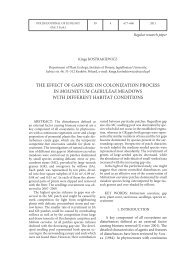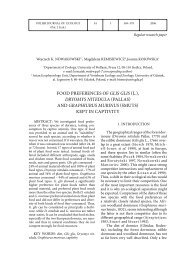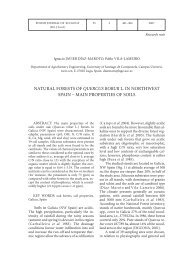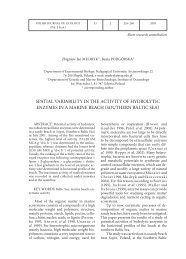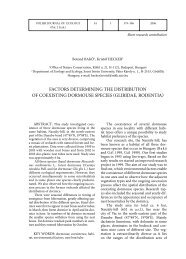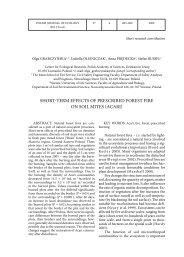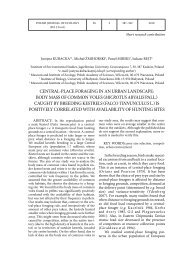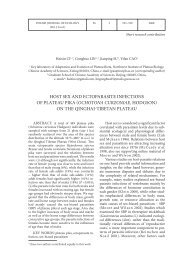EFFECT OF VEGETATION AND SOIL CONDITIONS ON BURROW ...
EFFECT OF VEGETATION AND SOIL CONDITIONS ON BURROW ...
EFFECT OF VEGETATION AND SOIL CONDITIONS ON BURROW ...
You also want an ePaper? Increase the reach of your titles
YUMPU automatically turns print PDFs into web optimized ePapers that Google loves.
406<br />
Gholamreza Naderi et al.<br />
Table 2. Mean (SD) values of physical characteristics of 15 burrow systems (Fig. 1) of A. firouzi.<br />
summer burrow<br />
(N = 5)<br />
winter burrow<br />
(N = 5)<br />
temporary burrow<br />
(N = 5)<br />
Feature Mean SD Mean SD Mean SD<br />
Length (cm) 109 19.27 363.80 111.94 72.20 14.61<br />
Number of entrance holes 2.60 0.54 5.20 1.30 1.20 0.44<br />
Depth of nest chamber<br />
(cm)<br />
59.60 8.29 84.20 9.03 41.20 9.78<br />
Number of dead ends 0.71 0.91 2.61 1.35 0.54 0.25<br />
meter to the nearest 0.5 cm. Further burrow<br />
systems were not excavated, to minimize disturbance<br />
to the studied population.<br />
3.2. Burrow site selection<br />
The burrow densities were studied in four<br />
habitat types (see the Study area) via random<br />
transects. For identifying the burrows in the<br />
study area different methods were used including<br />
for example following the individuals<br />
in the late activity period at night, searching<br />
for unbound previous year burrows and looking<br />
for plugged soil with different colours and<br />
humidity from ambient soil. In each habitat<br />
type, the burrow numbers were counted in 36<br />
random transects (transect length = 2 km).<br />
The microhabitat variables were measured<br />
in 66 burrow plots (presence) and the same<br />
number of the non-burrow plots (paired<br />
plots) (absence). The paired plots were selected<br />
randomly in about 500 meters away from<br />
the burrow plots (Naderi et al. 2009).<br />
In each habitat type a 10 × 10 m square<br />
area surrounding the sampling points was<br />
plotted (e.g. burrows in burrow plots) and the<br />
following microhabitat variables were measured:<br />
BSC – bare soil percent, PEB – cover<br />
pebble cover, COB – cobble percent cover,<br />
AAC, PHC and ASC respectively for the percent<br />
cover of A. aphylla, P. harmala and A. siberi.<br />
The percentage of canopy cover at crown<br />
level was estimated with the aid of a squared<br />
hard paper frame (25 × 25 cm). The arithmetic<br />
mean of the measurements of each variable<br />
was considered as the variables for the<br />
burrow plots and the paired (non-burrow )<br />
plots. A one kg soi l sample was taken from<br />
the centre of each plot for laboratory analysis<br />
of soil texture and of content of CaCO 3<br />
,<br />
CaSO 4<br />
, sand, pebble, silt and clay. Soil properties<br />
were studied independently of other<br />
mentioned microhabitats.<br />
3.3. Data analysis<br />
Structural differences in burrow systems<br />
a nd significant differences in burrow density<br />
was determined by ANOVA. A Two-way<br />
ANOVA was used to compare microhabitat<br />
variables between burrow and paired (nonborrow)<br />
plots across the whole study area<br />
with habitat type and the presence versus<br />
the absence of the burrows as fixed factors.<br />
The principal component analysis (PCA) was<br />
used to determine the most influential microhabitat<br />
variables (including BSC, AAC, ASC,<br />
PHC, PEB and COB) on the burrow site selection.<br />
To determine important microhabitat<br />
characteristics for burrow site selection<br />
within each habitat type, a paired t-test was<br />
used to compare microhabitat variables measured<br />
in burrow plots and paired (non- burrow)<br />
plots.<br />
The 66 soil samples from the burrow<br />
presence plots were compared with the same<br />
number from the paired plots (non-burrow<br />
plots) by applying dependent t-student test.<br />
The SPSS 16.0 statistical package was used for<br />
statistical analysis.<br />
4. RESULTS<br />
4.1. Structure of burrow systems<br />
The number of entrance holes in the excavated<br />
burrows ranged from one to nine per<br />
system and the number of tunnels ranged<br />
from 2 to 15, depending on the burrow system.<br />
The temporary burrow represents the<br />
simplest type which functions as an escape<br />
burrow (Fig. 1). These burrows have one nest<br />
chamber and a few (1–2) entrance holes per<br />
each burrow. The length of the system was<br />
smaller than in the summer or winter burrows.<br />
The summer burrows contained one<br />
nest chamber with a total length ranging from<br />
journal 26.indb 406 2011-06-28 10:20:52




